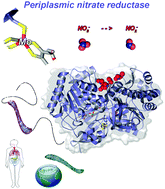Nitrate and periplasmic nitrate reductases
Abstract
The nitrate anion is a simple, abundant and relatively stable species, yet plays a significant role in global cycling of nitrogen, global climate change, and human health. Although it has been known for quite some time that nitrate is an important species environmentally, recent studies have identified potential medical applications. In this respect the nitrate anion remains an enigmatic species that promises to offer exciting science in years to come. Many bacteria readily reduce nitrate to nitrite via nitrate reductases. Classified into three distinct types – periplasmic nitrate reductase (Nap), respiratory nitrate reductase (Nar) and assimilatory nitrate reductase (Nas), they are defined by their cellular location, operon organization and active site structure. Of these, Nap proteins are the focus of this review. Despite similarities in the catalytic and spectroscopic properties Nap from different Proteobacteria are phylogenetically distinct. This review has two major sections: in the first section, nitrate in the nitrogen cycle and human health, taxonomy of nitrate reductases, assimilatory and dissimilatory nitrate reduction, cellular locations of nitrate reductases, structural and redox chemistry are discussed. The second section focuses on the features of periplasmic nitrate reductase where the catalytic subunit of the Nap and its kinetic properties, auxiliary Nap proteins, operon structure and phylogenetic relationships are discussed.


 Please wait while we load your content...
Please wait while we load your content...